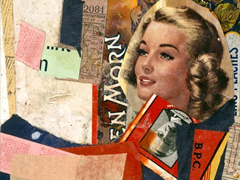Schwitters in Britain is the first major exhibition to examine the late work of Kurt Schwitters, one of the major artists of European Modernism. The exhibition focuses on his British period, from his arrival in Britain as a refugee in 1940 until his death in Cumbria in 1948. Schwitters was forced to flee Germany when his work was condemned as ‘degenerate’ by Germany’s Nazi government and the show traces the impact of exile on his work. It includes over 150 collages, assemblages and sculptures many shown in the UK for the first time in over 30 years.
Schwitters was a significant figure in European Dadaism who invented the concept of Merz – ‘the combination, for artistic purposes of all conceivable materials’. Whether those materials were string, cotton wool or a pram wheel, Schwitters considered them to be equal with paint. He is best known for his pioneering use of found objects and everyday materials in abstract collage, installation, poetry and performance. Schwitters’s time in Britain was quite extraordinary and continues to reverberate today, with the influence he has exerted over artists such as Richard Hamilton, Eduardo Paolozzi and Damien Hirst.
Exhibition highlights include an early example of Schwitters’s unique concept of Merz in the assemblage Merz Picture 46 A. The Skittle Picture 1921, the sculpture Untitled (Birchwood Sculpture) 1940 carved on his journey to Britain, and his collaged travelling trunk. Schwitters’s collages often incorporated fragments from packaging and newspapers reflecting British life such as the London bus tickets and Bassetts Liquorice Allsorts wrappers used in Untitled (This is to Certify That) 1942. The exhibition reunites a group of works shown in his 1944 London solo show at The Modern Art Gallery including the important assemblage Anything with a Stone 1941–4.
Schwitters in Britain
Tate Britain, Millbank, London

Ad
Event has ended
This event ended on Sunday 12th of May 2013
This event ended on Sunday 12th of May 2013
Admission
£10
£10
Website
Tags:
Art
Recommended
User Reviews
There are no user reviews
